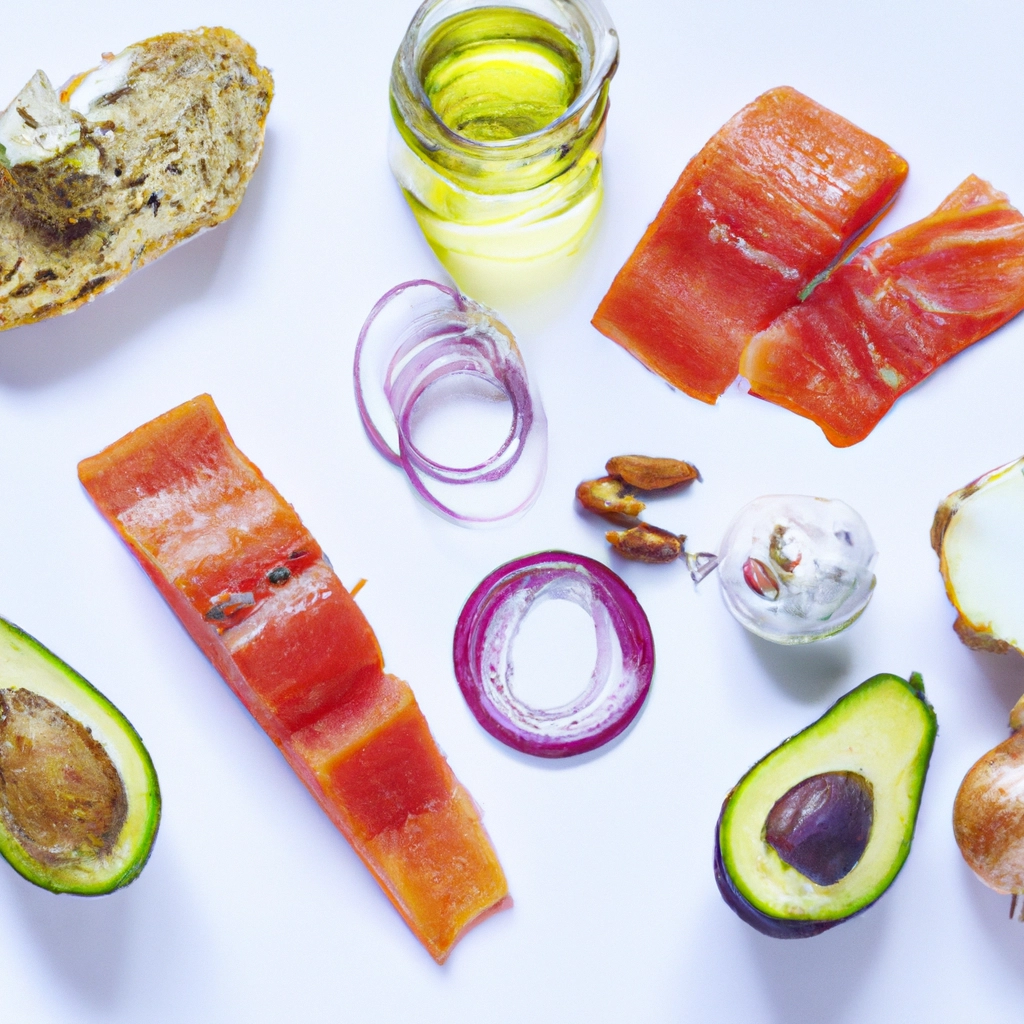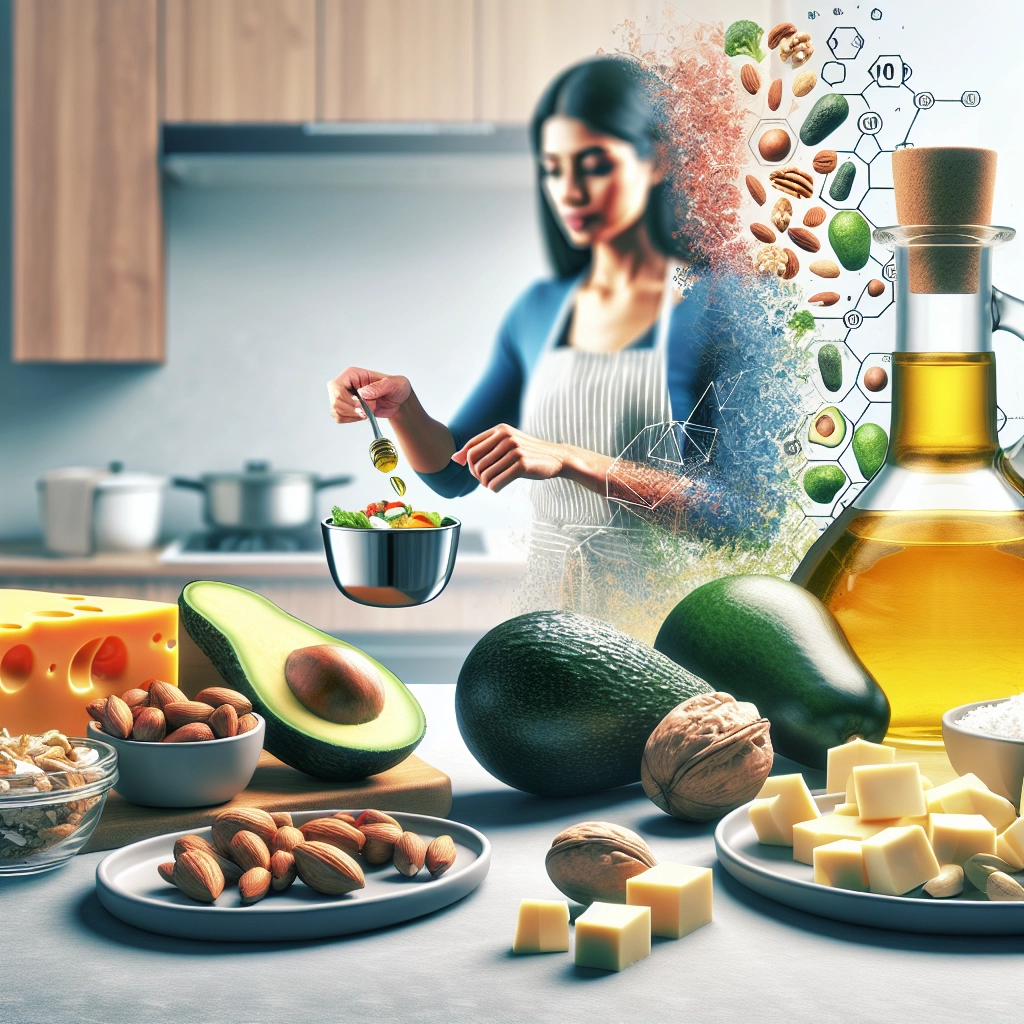

The keto diet is an eating pattern that includes high amounts of fat, low to moderate amounts of protein, and very little carbohydrates. Consuming 100 grams of fat per day on a keto diet can help shift the body’s metabolism away from carbs and toward fat and ketones.
This can lead to potential benefits such as weight loss, reduced risk of heart disease, and improved lipid profiles.
The ketogenic diet consists of foods like butter, cheese, eggs, meat, nuts, oils, seafood, and seeds, all of which are high in fat. By consuming these foods, it is possible to reach the goal of eating 100 grams of fat per day on a keto diet.
Some people choose to track their macronutrient intake to ensure they are reaching their fat consumption goals, which can be helpful for those new to the diet. It is important to note that consulting with a healthcare professional before starting any new diet is always recommended.
Check out this Youtube video:
Understanding the Keto Diet
What is a keto diet?
A keto diet is a low-carb, high-fat diet that focuses on drastically reducing carbohydrate intake and replacing it with healthy fats. By doing so, the body enters a state of ketosis, where it becomes incredibly efficient at burning fat for energy.
The importance of macronutrient ratios on a keto diet
On a keto diet, the macronutrient ratios are crucial. It typically consists of 70-80% of calories from fat, 5-10% from carbohydrates, and 10-20% from protein.
This balance ensures that the body remains in ketosis, maximizing fat burning and metabolic efficiency.
How the keto diet works to achieve fat loss and improve overall health
The keto diet works by forcing the body to rely on fat stores for energy, leading to significant fat loss. Additionally, it has been associated with improved metabolic health, reduced hunger, and increased calorie expenditure.
It also plays a role in decreasing overall body fat and promoting fat loss over lean body mass, making it effective for weight management.
Setting Your Macronutrient Goals
Calculating the ideal macronutrient ratio for a keto diet
The ideal macronutrient ratio for a keto diet is approximately 70-80% of daily calories from fat, 5-10% from carbohydrates, and 10-20% from protein.
Estimating the daily fat intake requirement for a 100-gram fat goal
To achieve a 100-gram fat goal, one should estimate daily fat intake based on their total caloric intake. For instance, on a 2000-calorie keto diet, approximately 155-177 grams of fat would be required to reach the 100-gram fat goal.
Understanding the role of protein and carbohydrates in a keto diet
In a keto diet, protein plays a crucial role in maintaining muscle mass and overall body function, typically contributing to 10-20% of the daily calorie intake. Carbohydrates are restricted to 5-10% of daily calories, as they are minimized to induce and maintain ketosis for fat burning.
Choosing the Right Sources of Fat
To identify healthy sources of fat for a keto diet, focus on incorporating foods like fatty fish (salmon, mackerel), avocados, coconut oil, and olives. These foods are rich in healthy fats and are ideal for a keto diet.
When incorporating a variety of fats into your diet, consider both saturated and unsaturated fats. For saturated fats, opt for foods like butter, ghee, and fatty cuts of meat.
For unsaturated fats, include olive oil, avocados, and nuts in your meals and snacks.
Practical ways to add healthy fats to your meals and snacks include using olive oil for cooking, adding avocado to salads and smoothies, and including nuts and seeds as snacks. Additionally, incorporating fatty fish into your meals provides a delicious and nutritious source of healthy fats.
| Saturated Fats | Unsaturated Fats |
|---|---|
| Butter | Olive oil |
| Ghee | Avocado |
| Fatty meats | Nuts and seeds |
Planning Your Meals
Creating a sample meal plan to reach the 100-gram fat goal
To create a sample meal plan to achieve the 100-gram fat intake, you can start with a breakfast rich in healthy fats like avocados and eggs, followed by a lunch consisting of fatty fish like salmon and a sprinkling of nuts for a snack. End the day with a dinner featuring olive oil drizzled over vegetables and a serving of cheese.
Tips for meal prepping and batch cooking to ensure you meet your fat intake target
When it comes to meal prepping for a high-fat diet, focus on preparing meals centered around fatty ingredients such as coconut oil, butter, and nuts. Batch cooking can be helpful for ensuring your meals are consistently high in fat, allowing you to portion out servings with your target fat intake in mind.
Recipe ideas and cooking techniques to increase fat content in your meals
Consider incorporating recipes that use high-fat ingredients like coconut milk-based curries, nut butter sauces for vegetables, and generous use of olive oil in salad dressings and sautéing. Cooking techniques such as roasting vegetables in olive oil or butter and pan-frying in coconut oil can significantly boost the fat content of your meals.
How to Eat 100 Grams of Fat Per Day on Keto
Tips for consuming high-fat foods throughout the day
When aiming to consume 100 grams of fat per day on the keto diet, focus on incorporating high-fat foods into your meals and snacks throughout the day. Start by adding healthy fats like avocados, nuts, seeds, and olive oil into your meals to reach your fat intake goals.
Incorporating fat bombs and keto-friendly snacks into your diet
Consider incorporating fat bombs and keto-friendly snacks into your diet to boost your fat intake. These can include almond-based fat bombs, avocado-based snacks, and other low-carb, high-fat options that can help you reach your daily fat intake requirement.
Be mindful of the ingredients to ensure they align with your dietary preferences and requirements.
Balancing fat intake with other macronutrients to maintain a well-rounded diet
While focusing on consuming 100 grams of fat per day on keto, it’s essential to balance your fat intake with adequate protein and a low amount of carbohydrates. Opt for high-quality sources of protein such as fish, poultry, and tofu, and select low-carb vegetables to complement your high-fat meals.
This balance will support a well-rounded keto diet while achieving your daily fat intake target.
Tracking Your Fat Intake
The importance of food tracking and monitoring your fat consumption
Tracking your fat intake is crucial in maintaining a balanced keto diet. It helps you understand the amount of fat you’re consuming, ensuring you stay within the recommended daily limit.
By keeping track, you can make necessary adjustments to optimize your fat intake for better results.
Recommended tools and apps for tracking macronutrients on a keto diet
When it comes to tracking macronutrients on a keto diet, there are some fantastic tools and apps available. One of the highly recommended apps is “Carb Manager,” which provides detailed insights into your macronutrient intake.
Another great option is “MyFitnessPal,” known for its user-friendly interface and extensive food database, making it easier to track your fat consumption effectively.
Adjusting your fat intake based on your progress and goals
As you progress on your keto journey, it’s vital to adjust your fat intake based on your goals and results. If you’re not seeing the desired outcomes, consider tweaking your fat consumption by either increasing or decreasing it.
Evaluation of your progress is key to making informed decisions about adjusting your fat intake for optimal success.
Overcoming Challenges
Common obstacles when trying to consume 100 grams of fat per day on a keto diet
Trying to consume 100 grams of fat per day on a keto diet can be challenging due to the misconception that all fats are unhealthy. People often fear that consuming high levels of fat will negatively impact their health and weight.
Additionally, it can be difficult to find appropriate food options to consistently meet this fat intake goal, especially for individuals accustomed to low-fat diets.
Strategies for dealing with social situations and dining out while maintaining a high-fat diet
When navigating social situations and dining out while maintaining a high-fat keto diet, it’s essential to communicate your dietary needs clearly. Choose restaurants with flexible menu options that allow customization to accommodate high-fat preferences.
Opt for dishes rich in healthy fats, such as avocados, olive oil, and fatty fish, to ensure you meet your fat intake goals while enjoying social gatherings.
Addressing concerns about cholesterol and other health implications of a high-fat diet
Addressing concerns about cholesterol and other health implications of a high-fat diet involves emphasizing the difference between healthy and unhealthy fats. Educate skeptics that the keto diet prioritizes healthy fats such as those from avocados, nuts, and seeds while minimizing trans fats and processed oils.
Emphasize that balanced high-fat intake, combined with low-carb consumption, can actually improve cholesterol levels and overall health.
Exercise and Fat Consumption
The role of exercise in a high-fat keto diet
- The role of exercise in a high-fat keto diet is crucial for optimizing fat utilization as a source of energy. When following a keto diet, the body becomes adapted to burning fat for fuel instead of carbohydrates. Engaging in regular exercise can help enhance the body’s ability to utilize dietary and stored fats effectively.
How to balance fat intake for energy and performance during workouts
- Balancing fat intake for energy and performance during workouts on a keto diet involves strategic meal planning. Incorporating healthy fats such as avocados, nuts, and olive oil into pre-workout meals can provide sustained energy for physical activity. Additionally, consuming medium-chain triglycerides (MCTs) can offer a quick source of energy during exercise.
Tips for optimizing your exercise routine to complement your fat consumption goals on keto
- To optimize your exercise routine while pursuing fat consumption goals on keto, consider incorporating low to moderate-intensity activities such as walking, cycling, or yoga. These exercises align well with the energy demands of a high-fat, low-carb diet. Moreover, ensuring adequate hydration and electrolyte balance is essential to support overall performance and recovery.
Seeking Professional Guidance
When to consult a healthcare professional or nutritionist about your fat intake on keto
Seek professional guidance if experiencing severe negative symptoms such as persistent fatigue, dizziness, or any health concerns. Also, consult with a healthcare provider if you have existing health conditions, especially diabetes or cardiovascular issues.
Understanding the importance of personalized advice for your dietary needs
Personalized advice is crucial as it considers individual health factors, ensuring the keto diet aligns with specific health goals and prevents potential adverse effects.
Ways to find a supportive and knowledgeable keto-friendly healthcare provider
Look for healthcare professionals experienced with ketogenic diets or dieticians with a specialization in low-carb nutrition. Seek recommendations from local keto communities or online platforms, ensuring the provider understands the nuances of the keto lifestyle.
Debunking Myths about Fat Consumption on Keto
The common misconception about the keto diet is that it promotes weight gain through excessive fat intake, leading to concerns about consuming 100 grams of fat per day on keto. However, the reality is that keto emphasizes prioritizing unsaturated fats, which can actually facilitate weight loss by promoting ketosis and metabolic fat burning.
Addressing misconceptions about fat intake on keto is crucial to dispel the myth that all fat consumption leads to weight gain, highlighting the importance of the type and quality of fats consumed. Myth: Consuming 100 grams of fat per day on keto leads to weight gain.
Addressing misconceptions about fat intake and weight gain
The keto diet prioritizes healthy unsaturated fats, which can actually promote weight loss through the metabolic process of ketosis, debunking the myth that all fat consumption leads to weight gain. Highlighting the scientific evidence supporting the benefits of a high-fat keto diet
Scientific research supports the benefits of a high-fat keto diet in promoting weight loss, metabolic fat burning, and improved satiety, dispelling the misconception that all fat consumption leads to negative health outcomes.
Rebutting common criticisms of consuming 100 grams of fat per day on keto
Common criticisms of consuming 100 grams of fat per day on keto are often based on misconceptions about the type and quality of fats consumed, overlooking the metabolic and satiating benefits of prioritizing unsaturated fats in the diet.
Success Stories and Testimonials
Real-life examples of individuals who have achieved their fat consumption goals on a keto diet
-
John’s Keto Journey: John struggled with weight for years until he discovered the keto diet. By following a high-fat, low-carb approach, he managed to consume 100 grams of fat per day, leading to significant weight loss.
-
Sarah’s Transformation: Sarah’s health and well-being underwent a remarkable change when she embraced the keto lifestyle. Consuming 100 grams of fat daily empowered her to achieve her health goals and feel more energetic throughout the day.
-
Michael’s Success Story: Michael’s experience with the keto diet is an extraordinary testament to the power of high-fat consumption. By committing to reaching the 100-gram fat target, he not only lost weight but also experienced a boost in mental clarity and focus.
How reaching the 100-gram fat target has impacted their health, weight loss, and overall well-being
| Success Story | Impact on Health and Weight Loss |
|---|---|
| John’s Keto Journey | Remarkable weight loss and increased energy levels |
| Sarah’s Transformation | Enhanced overall well-being and improved physical vitality |
| Michael’s Success Story | Mental clarity, focus, and significant reduction in body weight |
Inspirational stories to motivate and encourage readers to stick to their high-fat keto journey
- Never Give Up: These success stories serve as a motivational reminder that achieving the 100-gram fat target on a keto diet is not only possible but also transformative. Their journeys inspire and encourage individuals to persist on their own high-fat keto path towards better health and well-being.
Tips for Eating Out on Keto
Making conscious choices at restaurants to meet your fat intake goals
To meet your fat intake goals while dining out, opt for keto-friendly, high-fat options such as fatty cuts of meat, cheese, buttery sauces, and avocados. Avoid lean protein choices and opt for meals cooked in healthy fats like olive oil or coconut oil.
Ordering keto-friendly options while dining out
When dining out on a high-fat keto diet, consider ordering dishes like bunless burgers, grilled fish, or salads loaded with low-carb ingredients such as meat, cheese, and avocado. Additionally, ensure that the restaurant uses healthy fats in food preparation and inquire about any hidden sources of carbohydrates in the menu options.
How to navigate social gatherings and events while on a high-fat keto diet
Navigating social gatherings and events on a high-fat keto diet requires strategic planning. Prior to attending such events, prepare by having keto-friendly snacks on hand to avoid succumbing to high-carb temptations.
You can also plan your cheat day to align with such events to maintain dietary discipline.
Incorporating Intermittent Fasting with High Fat Consumption
Exploring the potential benefits of combining intermittent fasting with a high-fat keto diet
Intermittent fasting combined with a high-fat keto diet can have immense benefits for weight loss and overall health. By incorporating intermittent fasting, the body is encouraged to burn fat stores for energy due to the reduced availability of glucose, which is in line with the objectives of a high-fat keto diet.
Tips for structuring your eating window to maximize fat intake
To maximize fat intake during intermittent fasting, it’s essential to plan your eating window strategically. Consider consuming high-fat foods such as avocados, nuts, seeds, and fatty fish, within the limited eating period to meet the daily fat intake target.
The science behind how intermittent fasting and a high-fat diet work together for optimal health
Intermittent fasting and a high-fat diet work synergistically to shift the body’s metabolism from utilizing glucose as the primary energy source to burning fat for fuel. This process enhances fat oxidation and promotes ketosis, leading to efficient weight loss and improved metabolic health.
| Intermittent Fasting Benefits | High-Fat Keto Diet Benefits |
|---|---|
| 1. Promotes fat oxidation | 1. Enables ketosis for fat burning |
| 2. Supports weight loss | 2. Enhances satiety and energy levels |
| 3. Improves insulin sensitivity | 3. Balances cholesterol levels |
The Importance of Hydration and Electrolytes
Hydration plays a vital role in maintaining a high-fat keto diet. It aids in digestion, absorption, and transportation of nutrients, as well as in the regulation of body temperature and the maintenance of electrolyte balance.
Proper hydration also supports fat metabolism, which is crucial for achieving the goal of consuming 100 grams of fat per day on the keto diet. Electrolyte balance is essential for various bodily functions, particularly on a high-fat keto diet.
It helps regulate nerve and muscle function, maintain acid-base balance, and ensure optimal hydration levels. Consuming adequate electrolytes is crucial for preventing imbalances and supporting overall well-being while following a high-fat keto diet.
Staying hydrated while consuming a high-fat keto diet can be achieved through several strategies. It’s important to prioritize water intake and incorporate fluids from sources such as herbal teas, coconut water, and low-sugar electrolyte drinks.
Consuming hydrating foods with high water content, such as cucumbers, celery, and lettuce, can also contribute to overall fluid intake.
Hydration Strategies
Electrolyte Sources
Consume at least 8-10 glasses of water daily
Include potassium-rich foods like spinach and avocados
Drink low-carb electrolyte supplements if necessary
Incorporate sodium-rich foods like broth and pickles
Monitor urine color to assess hydration levels
Consider magnesium supplements for additional support
Electrolyte supplementation plays a supportive role in meeting fat consumption goals on the keto diet. By ensuring adequate levels of sodium, potassium, and magnesium, individuals can minimize the risk of electrolyte imbalances and associated symptoms, such as muscle cramps and fatigue.
Electrolyte supplements can be particularly beneficial during the initial stages of transitioning to a high-fat keto diet, helping to alleviate the symptoms of the “keto flu” and supporting overall well-being.
Mental and Emotional Well-Being on a High-Fat Keto Diet
Consuming 100 grams of fat per day on a keto diet can have a significant impact on mental and emotional well-being. The high-fat, low-carb nature of the keto diet can lead to improved mood stability, increased energy levels, heightened concentration, and reduced symptoms of anxiety and depression.
The diet’s reported therapeutic effects also include better cognitive function and possibly neuroprotective effects. This suggests that the high-fat keto diet can provide holistic support for mental health.
Addressing the psychological aspects of consuming high amounts of fat per day on a keto diet is crucial for success. Individuals may experience carb cravings, emotional eating, and a need to manage their mindset around fat consumption.
Strategies for managing these psychological aspects include regularly consuming balanced meals of high-quality protein, healthy fats, and low-carb vegetables to maintain healthy blood sugar levels and keep cravings at bay. Furthermore, practical tips such as increasing healthy fat intake, staying hydrated, and opting for natural sweeteners can help individuals manage sugar cravings on a keto diet.
Staying motivated and positive while following a high-fat keto diet is essential for long-term adherence. It’s important to set realistic goals, such as achieving specific weight loss targets or reaching particular body fat percentages.
Additionally, incorporating keto-specific positive affirmations and using powerful strategies like affirming one’s capability to reach their goals can greatly enhance motivation.
| Managing Cravings | Tips for Staying motivated |
|---|---|
| Balanced meals of protein, fats, and veggies | Set realistic, achievable goals |
| Tips to curb sugar cravings on keto | Utilize keto positive affirmations |
| Distinguishing emotional and physical hunger | Incorporate powerful motivational strategies |
Recommended Amazon Products for High-Fat Keto Diet
Here’s a curated list of products that can help you achieve high-fat keto diet with ease. These recommendations are based on the functionality, price, and reviews.
Bulletproof Brain Octane Oil
Bulletproof Brain Octane Oil is a high-quality source of energy-boosting MCT oil, perfect for incorporating into your high-fat keto diet. It’s sourced from coconuts and provides quick and sustainable fuel for your brain and body.
The product is highly rated for its purity and effectiveness in supporting ketosis.
Primal Kitchen Avocado Oil
Primal Kitchen Avocado Oil is a versatile and healthy fat option for your keto recipes, salads, and cooking needs. This cold-pressed avocado oil is rich in monounsaturated fats and vitamin E, making it a top choice for meeting your fat intake goals on a high-fat keto diet.
Customers rave about its mild flavor and excellent quality.
Perfect Keto Exogenous Ketone Base
Perfect Keto Exogenous Ketone Base can aid in achieving and maintaining ketosis, especially when you’re striving to consume 100 grams of fat per day on keto. This product offers a convenient way to increase your fat intake while supporting energy levels and mental clarity.
The brand is known for its clean ingredients and positive customer experiences.
To further assist in making your selection, here’s a breakdown of the pros and cons for each product using a table format:
| Product | Pros | Cons |
|---|---|---|
| Bulletproof Brain Octane Oil | 1. Pure source of MCT oil 2. Enhances energy levels 3. Positive customer reviews | 1. Relatively higher price point |
| Primal Kitchen Avocado Oil | 1. High-quality, cold-pressed oil 2. Rich in monounsaturated fats 3. Versatile for various recipes | 1. Availability may vary based on location |
| Perfect Keto Exogenous Ketone Base | 1. Supports ketosis 2. Convenient for fat intake 3. Clean ingredients | 1. Not everyone may require exogenous ketones |
Considering these options, the top recommended product for achieving a high-fat keto diet is Bulletproof Brain Octane Oil(https://www.amazon.com/s?k=Bulletproof+Brain+Octane+Oil). This MCT oil offers purity and effectiveness in supporting ketosis and energy levels.


Ready to improve your high-fat keto journey? Check out Bulletproof Brain Octane Oil(https://www.amazon.com/s?k=Bulletproof+Brain+Octane+Oil) today for the best results!


Conclusion
Achieving a 100-gram fat consumption goal on a keto diet involves focusing on healthy sources of fats such as avocados, nuts, and olive oil, while minimizing intake of unhealthy fats like processed oils and trans fats. It also requires careful tracking of fat intake and making adjustments to meals to ensure the goal is met.
Furthermore, it’s important for readers to take action and make sustainable changes to their dietary habits in order to reach their fat consumption goal. This may involve meal planning, seeking support from a healthcare professional or nutritionist, and being mindful of food choices on a daily basis.
Following a high-fat keto diet can lead to numerous benefits for overall health and well-being. These may include improved weight management, better blood sugar control, and increased energy levels.
It’s important for individuals to focus on the positive impact that making these dietary changes can have on their health.















